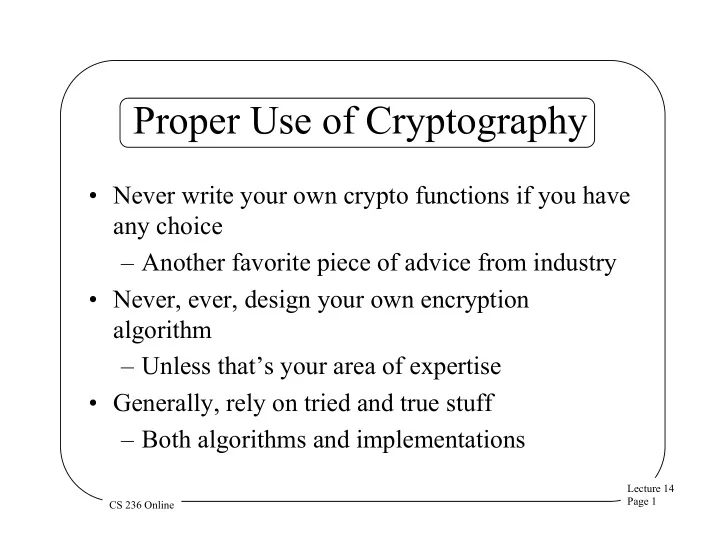

Proper Use of Cryptography • Never write your own crypto functions if you have any choice – Another favorite piece of advice from industry • Never, ever, design your own encryption algorithm – Unless that’s your area of expertise • Generally, rely on tried and true stuff – Both algorithms and implementations Lecture 14 Page 1 CS 236 Online
Proper Use of Crypto • Even with good crypto algorithms (and code), problems are possible • Proper use of crypto is quite subtle • Bugs possible in: – Choice of keys – Key management – Application of cryptographic ops Lecture 14 Page 2 CS 236 Online
An Example • An application where RSA was used to distribute a triple-DES key • Seemed to work fine • Someone noticed that part of the RSA key exchange was always the same – That’s odd . . . Lecture 14 Page 3 CS 236 Online
What Was Happening? • Bad parameters were handed to the RSA encryption code • It failed and returned an error • Which wasn’t checked for – Since it “couldn’t fail” • As a result, RSA encryption wasn’t applied at all • The session key was sent in plaintext . . . Lecture 14 Page 4 CS 236 Online
Another Example • Many pieces of malware use cryptography • RC4 is a frequent choice of cipher – Seems easy and fast • So the hackers implement it themselves • Which often gives the defenders advantages • Because the hackers screw it up • Being evil doesn’t necessarily make you smart Lecture 14 Page 5 CS 236 Online
Trust Management • Don’t trust anything you don’t need to • Don’t trust other programs • Don’t trust other components of your program • Don’t trust users • Don’t trust the data users provide you Lecture 14 Page 6 CS 236 Online
Trust • Some trust required to get most jobs done • But determine how much you must trust the other – Don’t trust things you can independently verify • Limit the scope of your trust – Compartmentalization helps • Be careful who you trust Lecture 14 Page 7 CS 236 Online
Two Important Lessons 1. Many security problems arise because of unverified assumptions – You think someone is going to do something he actually isn’t 2. Trusting someone doesn’t just mean trusting their honesty – It means trusting their caution, too Lecture 14 Page 8 CS 236 Online
Input Verification • Never assume users followed any rules in providing you input • They can provide you with anything • Unless you check it, assume they’ve given you garbage – Or worse • Just because the last input was good doesn’t mean the next one will be Lecture 14 Page 9 CS 236 Online
Treat Input as Hostile • If it comes from outside your control and reasonable area of trust • Probably even if it doesn’t • There may be code paths you haven’t considered • New code paths might be added • Input might come from new sources Lecture 14 Page 10 CS 236 Online
For Example • Shopping cart exploits • Web shopping carts sometimes handled as a cookie delivered to the user • Some of these weren’t encrypted • So users could alter them • The shopping cart cookie included the price of the goods . . . Lecture 14 Page 11 CS 236 Online
What Was the Problem? • The system trusted the shopping cart cookie when it was returned – When there was no reason to trust it • Either encrypt the cookie – Making the input more trusted – Can you see any problem with this approach? • Or scan the input before taking action on it – To find refrigerators being sold for 3 cents Lecture 14 Page 12 CS 236 Online
Variable Synchronization • Often, two or more program variables have related values • Common example is a pointer to a buffer and a length variable • Are the two variables always synchronized? • If not, bad input can cause trouble Lecture 14 Page 13 CS 236 Online
An Example • From Apache web server • cdata is a pointer to a buffer • len is an integer containing the length of that buffer • Programmer wanted to get rid of leading and trailing white spaces Lecture 14 Page 14 CS 236 Online
The Problematic Code while (apr_isspace(*cdata)) ++cdata; while (len-- >0 && apr_isspace(cdata[len])) continue; cdata[len+1] = ‘/0’; • len is not decremented when leading white spaces are removed • So trailing white space removal can overwrite end of buffer with nulls • May or may not be serious security problem, depending on what’s stored in overwritten area Lecture 14 Page 15 CS 236 Online
Recommend
More recommend